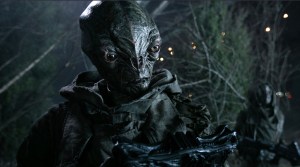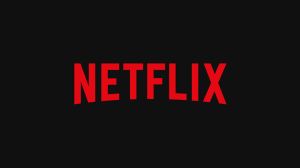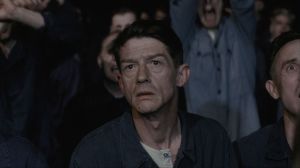The Scary Stories to Tell in the Dark series of books has been frightening young readers for decades, with this summer seeing the release of the concept’s feature-film adaptation. The movie not only brought to life some of the series’ most iconic tales, but also delivered viewers new experiences, resulting in a story that appealed to audiences familiar with the series and those with no connection to it. The film made for such a successful interpretation of the source material that it was brought back to theaters for Halloween weekend, as it made for the perfect way to get into the spirit of the spooky season.
Videos by ComicBook.com
A key component of the books and the film were the creatures contained in the story, with actor Mark Steger having brought the terrors to life for the film. The actor portrayed both Harold the Scarecrow and the Pale Lady in the new film, characters whose original illustrations by Stephen Gammell still cause readers nightmares. Additionally, the performer helped birth an all-new monster for horror fans, playing the Demogorgon in the first season of Stranger Things.
ComicBook.com recently caught up with Steger to discuss bringing the iconic characters to life, the collaborative filmmaking process, and his inspiration for the characters.

ComicBook.com: The original books have earned a passionate following in the decades since their release, did you have any connection to the source material?
Mark Steger: Unfortunately, no. They came out in the ’80s, and I was past them. I think they were released as children’s books, but I wasn’t a child in the ’80s, I was a child in the ’60s, early ’70s, so I didn’t actually know about them until I got a call about doing this film, and then I checked them out and I thought they were wonderful.
Gammell’s illustrations, I think they’re incredibly beautiful. I know they were considered shocking and grotesque at the time the books came out by a lot of people, and a lot of people didn’t think they were appropriate for children, but I think if I was a child and I’d seen those, I would have just eaten that stuff up. And the stories are beautiful. These beautiful little horror vignettes. I’m a big fan of the books now. I’ve read quite a few of the stories at this point.
Since you brought familiar characters to life, and with the makeup and prosthetics doing a lot of the work of looking visually similar to those characters, what was your performing process on capturing the essence of these characters and translating that to a film?
It’s very much a collaborative process. The two characters that I played, Harold and the Pale Lady, were very faithful representations of the illustrations from the books. That’s what [director] André [Øvredal] and [producer] Guillermo [del Toro] wanted, as far as the actual look of the character. I didn’t really have any part in that. My job is when I inhabit the makeup. These were some of the best people, too, who worked on this. Mike Hill sculpted and applied the Pale Lady and Norman Cabrera did Harold.
It’s very much a collaborative process. Because I’m inside the makeup, I have ideas that I bring about how to do the movement. We did a test and everybody seemed really happy with that, but until you’re actually fully in the makeup and you’re on set, you don’t fully understand the character. For me, I don’t. André had a lot of input into the movement, he had very specific ideas in mind. There was also a gentleman named Roberto Campanella, who was the movement coordinator, who works on a lot of Guillermo del Toro films. And he was there to coach me as well.
The guys who do the makeup, they have ideas as well. It’s good to get all these different takes on it, and you try to come up with something that is true to the character, really. With Harold, for instance, I wanted to make it look like there was nothing inside there. He’s supposed to be this ghost inhabiting this scarecrow. Part of what I was going for was to make it not seem like there was actually anyone inside animating it.
And the Pale Lady is just such a wonderful character. It was one of those things where sometimes what’s required is to do less. I think that André was really right with this, about not going overboard with the movement and not creating too much anticipation, because the look of this character just sold it. She’s really one of my favorite characters that I’ve ever done, actually.
That character must have been challenging because there’s so little to her physicality, as she just slowly walks down a hallway, which some people might think merely requires you to just walk slowly.
It was a little more challenging than that because I couldn’t see anything. Her actual eyes were spread far apart. The Pale Lady’s eyes that you see were outside of my range. Plus, they were opaque. So I was completely blind when we were doing that. Some of those long walks down the hallways, I’d start to veer to one side or the other. But the idea would be they’re giving me directions.
We never see your face in many of your projects, so audiences might react to your presence without them ever knowing who is responsible for those characters. What are the most rewarding elements of your performances? Is it seeing the film with an audience for the first time or are the joys found in the filmmaking process?
That’s a good question. I’m really process oriented and I love being on set and I love creating. Obviously there’s a lot of waiting around on set and it can be very challenging. When I’m actually on set and in front of the camera, I feel like I become this character and I’m inhabiting this world. And, to me, the process is really rewarding. And all the incredible people that I get to work with.
I’ve worked with some of the best artists and technicians in the world. It’s always satisfying when you can communicate something to an audience and you make them feel something. And often I experience that when I go to a theater. I don’t always experience it with an audience, but when I do, it’s very satisfying, but I feel like the process to me is the most satisfying part.
Are there any particular favorite movie monsters or performers that you return to as a source of inspiration with what they’ve accomplished through their blend of acting and heavy makeup?
There are characters from films that I’m very fond of, characters I grew up with, like Frankenstein, for instance. Any performance by Boris Karloff, pretty much. And then I’m actually a child of animation. I used to do animation when I was younger, and then I did it professionally for a while, so that has a big influence on me as well.
I love creatures like the Monster from the Id in Forbidden Planet. I think that’s such a wonderful character, or a representation of this guy’s subconscious. I look to nature a lot. I look to animal behavior quite a bit, depending on the character. I ask myself a lot of questions when I start working on something, trying to get into the psychology of the character, if it even has any psychology. Like a zombie, for instance, there’s not a whole lot going on generally with the higher brain functions, but I’ll ask myself what’s the gravity like where I come from, what’s the atmosphere like? What do I eat? Some basic actor questions like, what do I want? Does my character want anything besides eating?
Often it’s more complicated than that. Also, you speak with the director. You read the script, you speak to the director, and the good directors have specific ideas in mind about who your character is and what the behavior is like. Not necessarily specific movements, but they have an idea of how you should act. I draw from a lot of different sources. Of course, there’s amazing performers that I’ve seen in the past, either live or on film, and I love to be inspired that way as well. I draw influences from everywhere I can.
You mention having to think about characters from other worlds and, one character you’ve played from another dimension is the Demogorgon from Stranger Things. Were you at all involved in the monster’s Season Three appearance?
After Season One, everything is visual effects. Everything’s visual effects now. I understand, it happens all the time with creatures. I mean, not all the time, but it happens often. In a lot of ways, it’s easier for directors to work with CGI, because they can go back and make all the changes that they want. They can keep tweaking things as they go. I’m a bit agnostic as far as CGI versus practical effects.
But I think it’s what works for the project, and it’s how it’s executed and how it’s used. To me, what really pays off is the smart use of both, the two of them together. I think when that’s done well, that’s great. And I think Guillermo del Toro is actually somebody who’s really good at that. It’s the nature of how things are done now. There’s not necessarily a right or wrong way to do it, it’s really how you use the tools. These are all tools, right?
I think in a lot of ways, for the fans, it’s way cooler if there’s actual special makeup effects being used, because they can see this physical process and they can actually see … even have the opportunity to see the actual makeup live sometimes. I think if people saw the incredible Demogorgon suit and animatronics that Spectral Motion created for the Demogorgon, that people would be blown away. To see that live at a convention, for instance, I think that would be really incredible.
You might not have been familiar with Scary Stories to Tell in the Dark, but played the part of iconic characters. Now, with Stranger Things, you’ve given birth to another iconic monster for an entirely new generation. What’s your reaction to having this somewhat unseen impact on iconic characters?
I don’t dwell on it too much, but there have been times when I was like, wow, that’s really quite a phenomenon that the [Stranger Things creators] Duffers have created. And I’m pretty sure that no one who was involved thought it would become the kind of cultural touchstone that it has. When I first got involved, I met the Duffers and they were terrific guys, and I read the scripts. The scripts were above average, like, well above average. And then I met the other cast members and the crew, and I thought to myself, “Well, this is going to be one of those ones I can look back on and say, ‘I liked that. I enjoyed that experience. And I think it’s going to be a good series.’”
Really soon after it premiered, it started getting so much attention and buzz. And all the memes that were being shared online, and all the fan theories, it was crazy. But I think it’s really well deserved. It’s so well executed and so heartfelt. And at its core, it’s a sweetly human multigenerational odyssey, where you have all these characters that you really cared about. Even the bad guys, you know? You want to spend time with them.
I think it’s to the Duffers’ credit that they were able to create something that really resonated with so many people, and on a really deep level. And it’s not just about the ’80s nostalgia, because people do nostalgia stuff all the time. But this was an honest homage to a certain period and style of filmmaking that those guys grew up on and loved.
*****
Scary Stories to Tell in the Dark is out now on Digital HD and hits Blu-ray and DVD on November 5th.








